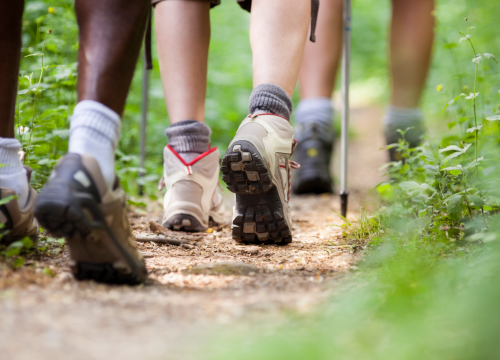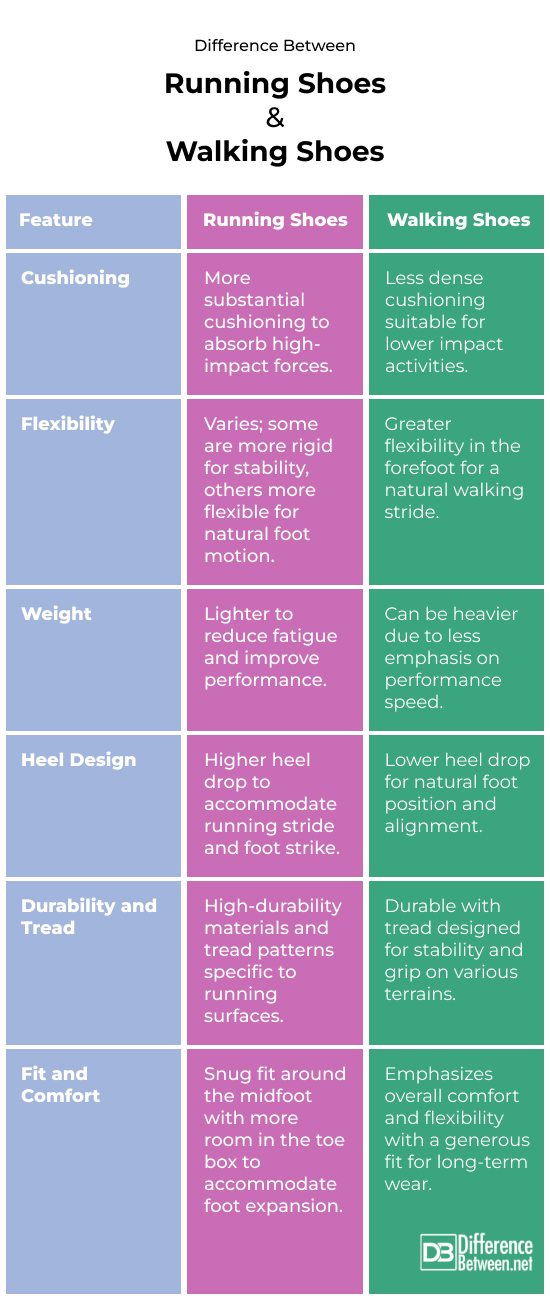Difference Between Running Shoes and Walking Shoes
Introduction
Choosing the right shoes is important for both success and avoiding injuries. For example, running shoes and walking shoes are designed to be used for different tasks. Running shoes are made to handle a lot of pressure and keep you stable, while walking shoes are made to be comfortable and flexible. This guide goes into detail about these differences and stresses how important it is to choose the right shoe to improve your physical exercise and keep you from getting hurt or uncomfortable.

What are Running Shoes?
Running shoes are specially made to help and improve the running experience. They are made to handle the high-pressure of running, which puts a lot of stress on the feet, knees, and legs. Their main job is to give runners the support, cushioning, and steadiness they need to absorb shock, lower the risk of injury, and make running more efficient.
Key Features
Running shoes have specific cushioning to absorb the impact applied on the foot while running. Cushioning reduces joint and muscle tension, thus reducing the risk of injury.
Stability: They aid runners with pronation difficulties, whom foot rolls inward very often. These features improve stride by aligning the foot in the right position while running.
Weight: Running shoes are balanced to protect and support without impeding performance. Higher-cushioned types are better for trail running and longer distances, while lighter ones are better for speedier, more competitive running.
Types of Running Shoes Based on Running Style and Foot Type
Low-overpronation runners need neutral shoes. The sneakers provide balanced cushioning without support.
Run stability shoes for mild-to-moderate overpronators. These shoes support and prevent inward foot rolling using medial posts or dual-density foams.
Motion Control Shoes: Firmer heels and a straighter design give runners with severe overpronation the best assistance.
Minimalist shoes promote a forefoot or midfoot strike with little cushioning and support for a “barefoot” running feel.

What are Walking Shoes?
Walking shoes are made to support the natural walking, making them comfortable and long-lasting for a long time. Their main goal is to make walking easier by giving their users better support, reducing foot fatigue, and lowering the risk of injuries. Running shoes are made to absorb high-impact forces. Walking shoes, on the other hand, are designed to help you walk naturally and comfortably at a slower pace.
Key Features
Flexibility: Walking shoes are made to be flexible, especially in the front of the foot, so that the foot can naturally roll from heel to toe as you walk.
Support: Walking shoes must have enough arch support to keep the foot straight and stop overpronation or supination, which can cause pain and injuries over long period of time. Support features change based on the type of arch in the walker.
Cushioning: Walking shoes do have cushioning to absorb shock, but the focus is not so much on thick, soft padding as it is on making the soles feel firm and responsive. This keeps you stable and comfortable on long walks without adding too much padding.
Design Variations for Different Types of Walkers
Shoes for casual walking: Casual walking shoes are made to be worn every day and for light walking. They are stylish, comfortable, and supportive. These shoes are good for people who walk for fun or to get to work.
Fit Walking Shoes: These shoes are for people who walk for exercise or to get faster. They usually have features that are more focused on performance, like better breathability, lighter build, and better grip.
Hiking Walking Shoes: These shoes are made for people who love the outdoors and like to walk on paths and uneven ground. They have tough outsoles for grip, waterproof materials, and better durability.
Motion Control Walking Shoes: These shoes are great for people who walk a lot and have extreme overpronation because they have structured support and a more rigid heel counter that keep the foot aligned and stop it from moving too much.
Walking shoes with arch support: Because they are made for people with foot health problems or who need custom orthotics, orthopedic walking shoes have extra depth, detachable insoles, and wider toe boxes to fit different foot conditions.
Possible Similarities Between Running Shoes and Walking Shoes
Even though they are made for different activities and have different styles, running shoes and walking shoes have a lot in common. These features show that the shoes help you move in a healthy and comfortable way, no matter what kind of exercise you are doing.
Designed for Forward Motion: Both types of shoes are best for tasks that require you to move forward a lot. This design factor affects the structure and function of the shoes as a whole, making sure they support the natural cycle of walking or running. The tech behind both running and walking shoes is meant to help you move forward efficiently while putting as little stress as possible on your feet and legs.
Focus on Comfort and Cushioning: Comfort is the most important thing in both running and walking shoes. Companies that make shoes spend money on technologies and materials that provide good cushioning to absorb pressure and make the wearer more comfortable. There are different levels and kinds of cushioning, with running shoes usually needing more to absorb more impact forces. However, both types are meant to make sure you are comfortable while doing their specific activities.
Styles that fit different types of feet are available: Different foot shapes, sizes, and physiological needs are taken into account, so running and walking shoes come in a lot of different styles to fit all of these foot types. If you have a high arch, flat feet, or need extra support because your feet roll in too much, makers make models that are made to fit your needs. This makes sure that everyone can find the right shoe to support their unique foot shape and help them do better in their activities.
Key Differences Between Running and Walking Shoes
Differences in Support and Cushioning
Running shoes usually have better padding in the midsole to absorb shock when you run. The traits that help runners deal with overpronation and supination in their strides.
Walking shoes have less thick cushioning to absorb shock from walking’s lower impact. The support makes it more comfortable to do light activities for long periods of time, not to walk.
Flexibility
Depending on the way you run, your running shoes may need to be hard for stability or flexible to let your feet move naturally.
Walking shoes should have a flexible forefoot so that the foot can roll through easily as you walk. This will make you more comfortable and save you time.
Weight and Design of the Heel
Running shoes: Lighter shoes make you less tired and help you do better in races. They might have a higher heel drop for the foot strike and propelling part of running.
Walking shoes with lower heel drops help your feet stay in a natural position and aligned, which is good for walking at a steady speed.
Traction and Durability
The materials used to make running shoes are strong enough to handle running on a variety of surfaces. The tread patterns are designed to give you grip whether you are running on roads or trails.
Even though walking shoes are strong, their tread design gives you stability and grip for a smoother walk on a variety of surfaces. They have less aggressive track patterns than trail running shoes.
How It Fits and Feels
Because your feet swell during long runs, it is important that your running shoes fit well to avoid bruises and toenail damage. Some running shoes may have more toe room and a tighter fit around the midfoot.
Walking shoes should be soft, comfortable, and have a looser fit to help with foot swelling after long walks. Long-term comfort is more important than performance.
Difference Between Running Shoes and walking shoes

Summary
This article talks about the main differences between walking shoes and running shoes. It stresses how important it is to choose the right type based on features like cushioning, flexibility, and support that are designed for that exercise. Picking the right shoes is important for improving speed, comfort, and avoiding injuries, making sure that both runners and walkers have the best experience possible.
FAQs
Is it OK to use running shoes for walking?
Yes, it’s generally fine to use running shoes for walking. Running shoes offer ample cushioning and support, which can also be beneficial for walking.
Can you use the same shoes for walking and running?
While you can use the same shoes for both activities, it’s not ideal. Dedicated shoes for each activity ensure you get the specific support and durability needed for each.
How do you know if shoes are for running or walking?
Running shoes typically have more cushioning in the heel and are built for higher impact. Walking shoes have more flexible soles and offer a wider range of motion for the foot.
Is it OK to wear running shoes everyday?
Yes, but wearing running shoes daily for casual wear can lead to quicker wear and reduce their effectiveness for running.
Which type of shoes are best for daily use?
For daily use, choose shoes that offer comfort, support, and suit your foot type. Walking shoes or casual sneakers are often designed for comfort during prolonged wear.
Can I wear running shoes if I don’t run?
Yes, you can wear running shoes even if you don’t run, as they provide good cushioning and support for everyday activities.
When should I stop using my running shoes?
You should stop using your running shoes when they start to show significant wear, such as worn-out treads, diminished cushioning, or when they no longer provide proper support, typically between 300-500 miles.
When should I replace my running shoes for walking?
Similar to running, replace your walking shoes when they show signs of wear or no longer offer adequate support, generally after 300-500 miles of use.
How do you tell when your running shoes are worn out?
Signs include worn-down tread, uneven wear on the soles, discomfort, or decreased shock absorption.
How long are walking shoes good for?
Walking shoes typically last for about 300-500 miles, depending on walking style, weight, and surface walked on. Monitor for wear and replace as needed to ensure continuous support and comfort.
- Difference Between Suicide and Euthanasia - May 22, 2024
- Difference Between Vitamin D and Vitamin D3 - May 21, 2024
- Difference Between Running Shoes and Walking Shoes - April 30, 2024
Search DifferenceBetween.net :
Leave a Response
References :
[0]Goonetilleke, R. S., & Cann, M. T. (1995, October). Perceived differences in running and walking shoes. In Proceedings of the Human Factors and Ergonomics Society Annual Meeting (Vol. 39, No. 5, pp. 336-340). Sage CA: Los Angeles, CA: SAGE Publications.
[1]Morio, C., Lake, M. J., Gueguen, N., Rao, G., & Baly, L. (2009). The influence of footwear on foot motion during walking and running. Journal of biomechanics, 42(13), 2081-2088.
[2]Kim, E. H., Chung, C. W., & Lim, J. (2006). The biomechanical evaluation of new walking-shoes. Korean Journal of Sport Biomechanics, 16(2), 193-205.
[3]Goonetilleke, R. S., & Cann, M. T. (1995, October). Perceived differences in running and walking shoes. In Proceedings of the Human Factors and Ergonomics Society Annual Meeting (Vol. 39, No. 5, pp. 336-340). Sage CA: Los Angeles, CA: SAGE Publications.
[4]Goonetilleke, R. S., & Cann, M. T. (1995, October). Perceived differences in running and walking shoes. In Proceedings of the Human Factors and Ergonomics Society Annual Meeting (Vol. 39, No. 5, pp. 336-340). Sage CA: Los Angeles, CA: SAGE Publications.
[5]Image credit: https://www.canva.com/photos/MADGyBPaG-4-people-doing-marathon/
[6]Image credit: https://www.canva.com/photos/MAATFCvdR10-shoes-of-people-trekking-in-wood-and-walking-in-row/
[7]Kim, E. H., Chung, C. W., & Lim, J. (2006). The biomechanical evaluation of new walking-shoes. Korean Journal of Sport Biomechanics, 16(2), 193-205.
